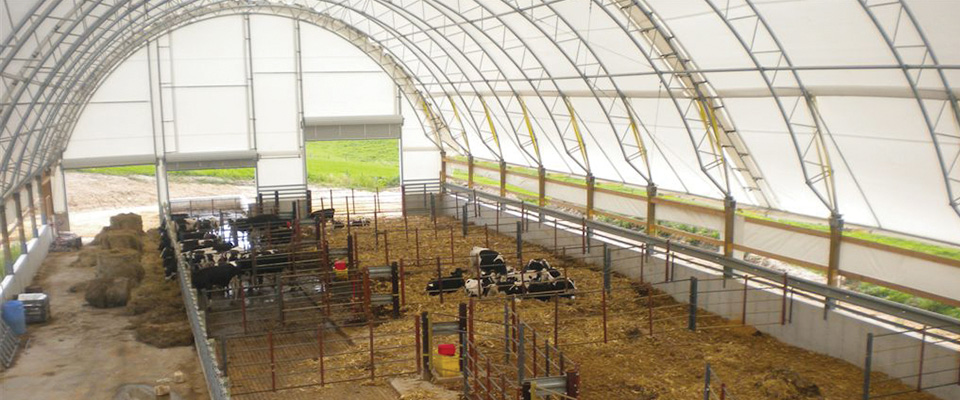Barn Ventilation Design: Getting it Right
August 10, 2018
The Basics of Barn Ventilation
The difference between a hot, musty barn and a cool, fresh-smelling barn is an effective barn ventilation system. This is especially true in livestock applications, where moisture and odor accumulate quickly. Inadequate ventilation is not just uncomfortable for workers, it can make animals develop respiratory health problems. Making effective use of both passive (natural) and active (mechanical) ventilation systems will displace moisture, heat, pathogens, odor and harmful gases, like ammonia and carbon dioxide.
Passive ventilation relies only on the force of wind and building openings, such as ridge vents, open sidewalls, eaves and rollup doors, to allow fresh air to flow through the barn. The main advantage of a passive ventilation system is affordability, as there is no electrical usage. Passive ventilation is most often found in northern regions where it does not get exceptionally hot in the summertime. On days without wind or when outside temperatures exceed the ones inside the barn, passive ventilation will not provide an adequate amount of cooling air to the barn. That’s why it’s important to have a ventilation design that integrates both passive and active techniques.
Active ventilation is the process of using fans, baffles and air inlets to gain control over air flow patterns. It’s used when temperatures need to be more tightly controlled. Before placing any fans or inlets in a barn, building owners should confirm where the prevailing winds come from and place fans on the opposite side.
Ventilation Design – Top Options
When it comes to passive ventilation designs, cross ventilation is a popular method that makes the wind work to the barn owner’s fullest advantage. Cooler outside air is forced into the building through inlets, while warmer inside air is funneled out through roof vents or windows. Inlets can include a variety of features, like interior ceiling baffles, wall louvers, a gable or simply an open window.
Cross ventilation constantly renews the air inside the building, keeping it fresh, while also lowering the temperature considerably. It’s important to make sure that inlet and outlets are similarly sized, so that there is roughly the same amount of wind coming in as is going out. Cross ventilation doesn’t cost a thing, since it doesn’t rely on electronics. However, because it relies completely on wind availability, it will not be the most effective way to ventilate a barn when heat and humidity levels are extremely high.
Active ventilation is made up of three main styles: tunnel, positive pressure and negative pressure ventilation. The most common method of active ventilation is to use fans on one side to exhaust warm air out, while drawing cool air in through inlets placed on the other side of the building. This means that air temperature and air flow within a barn can be controlled, even when there’s no wind.
Tunnel ventilation, which is ideal in barns with ceilings, pulls air along the barn using exhaust fans and empties it out on the opposite side. This type of ventilation is very effective at helping cows get rid of body heat during the summer and can lower the temperature inside the barn by up to 15 degrees. Although it’s a great cooling system in the summer, tunnel ventilation is generally not effective in cold weather, as it can create drafts in the wintertime.
Positive pressure ventilation draws cool, fresh air from fans in the end walls and into individual stall beds through ducts. This method is known to lower pathogens and reduce the risk of respiratory diseases in dairy cows. The ducts used in positive pressure ventilation are easy to install and cost-efficient. This approach to ventilation is necessary where doors have to stay open for livestock to enter and exit the building. In order for positive pressure ventilation to work properly, the barn must have airtight construction.
Negative pressure ventilation exhausts air out of the barn using fans and uses air inlets to distribute cool air inside. The exhaust fan must be matched with the air inlets to ensure outside air mixes well with inside air. If the doors on the barn can remain shut occasionally, a negative pressure ventilation system would be preferable. This ventilation design should be sized for mild weather, winter weather and summer weather. Tight construction is not a requirement for negative pressure ventilation.
A passive barn ventilation system can be used in place of active ventilation during the cold winter months to make sure temperatures don’t drop too low. Some farmers design hybrid barns that integrate passive ventilation with tunnel ventilation. This maintains high quality air that is fresh and free of humidity during the winter. Combining passive and active ventilation is also energy efficient, as it lowers utility costs for part of the year.
No matter what combination of cooling systems are used, a barn’s ventilation system should work equally well in the summer and the winter. If the barn is used to house livestock, there should always be fast moving air in their resting spots to ensure consistently good quality air. Whether a barn is located in a region that’s always warm or a place that goes through all four seasons, the appropriate ventilation design will ensure long-term success.
ClearSpan Fabric Structures provides some of the finest livestock and hay storage solutions, all of which provide plenty of natural ventilation. Request a Quote to get your project started or to get more project-specific information.

